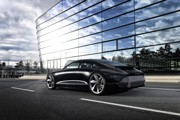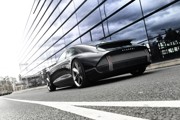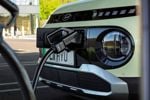Hyundai has revealed more details of its Prophecy Concept EV, following the car’s virtual unveil last month.
The vehicle was built to showcase ideas and features the brand will develop for future production models – hence the name Prophecy.
Hyundai has not revealed any details of the Prophecy’s powertrain, but says the car is based on its Electric Global Modular Platform (E-GMP). Currently, none of the brand’s production EVs use this platform.
Inspired by the vintage cars of the 1920s and 30s, the Prophecy has a smooth, coupe-like design.
Its dynamic shape and rear spoiler give it a sporty appearance, and propeller-shaped wheels reduce air resistance. This look is based on Hyundai’s design identity: Sensuous Sportiness.
“The word ‘sensuous’ integrates the value of more emotion in our designs. ‘Sportiness’ implies dynamics, to be reactive of what’s happening around us,” said Hyundai Motor Group’s chief design officer Luc Donckerwolke. “Sensuous Sportiness is not about a new language or philosophy. It’s about a new concept in the creation of our cars.”
Rather than a steering wheel, the Prophecy is controlled by dual joysticks located left and right from the driver: one on the centre console and the other on the door trim. Hyundai says this provides a more comfortable seating position and frees up more space on the dashboard for other features.
The new Smart Posture Care System (SPCS) will automatically adjust the seat position according to the driver’s height, seated height, and weight.
A large infotainment screen stretches across the entire front of the vehicle’s interior. When not driving, the car can be used as an entertainment space by switching into Relax Mode. In Relax Mode, the seats recline and the dashboard swivels upwards, creating the optimal seating position from which to enjoy the content shown on the display. Because of the lack of a steering wheel, the occupants have virtually zero visual obstacles – they see only the horizontal pillar-to-pillar display and the wing-shaped dashboard. As autonomous driving technology progresses, the potential for vehicles to be used as relaxation spaces will grow in importance.
To protect occupants from harmful pollution, an air filtration system with a fine dust sensor provides clean air when required. The windows cannot be opened, instead the car pumps in fresh, clean, air and removed stale air using the new system.



























Login to comment
Comments
No comments have been made yet.